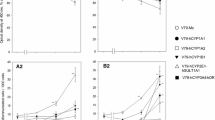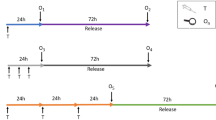Abstract
1-Methylpyrene (1-MP) is a common environmental pollutant and animal carcinogen. After sequential activation by cytochromes P450 and sulfotransferases, it induced gene mutations and micronuclei in mammalian cells. The type of micronuclei formed, entire chromosomes or fragments, was not analysed. In this study, 1-MP and its primary metabolite, 1-hydroxymethylpyrene (1-HMP), were investigated for the induction of centromere-positive and -negative micronuclei in the human hepatoma cell line HepG2 and its derivative C3A, expressing relevant enzymes at higher levels. Under a short-exposure (9 h)/long-recovery regime (2 cell cycles in total), 1-MP and 1-HMP provided negative test results in HepG2 cells. However, they induced micronuclei in C3A cells, the effect being blocked by 1-aminobenzotriazole (inhibitor of cytochromes P450s) and reduced by pentachlorophenol (inhibitor of sulfotransferases). Immunofluorescence staining of centromere protein B in the micronuclei revealed purely clastogenic effects under this regime. Unexpectedly, 1-MP and 1-HMP at concentrations 1/5–1/4 of that required for micronuclei formation led to mitotic arrest and spindle aberrations, as detected by immunofluorescence staining of β- and γ-tubulin. Following extended exposure (72 h, 2 cell cycles, no recovery), damage to the spindle apparatus and centrosomes was detected at even lower concentrations, with concurrent formation of micronuclei. At low concentrations (1–8 µM 1-MP, 0.25–0.5 µM 1-HMP), the micronuclei induced were unexceptionally centromere-positive. Thus, the chromosome-damaging mechanism of 1-MP was regime and concentration dependent: potently aneugenic under persistent exposure, while clastogenic at higher concentrations following a short-exposure/long-recovery regime. This is a convincing evidence for the existence of metabolic activation-dependent aneugens.



Similar content being viewed by others
References
Andrae U, Kreis P, Coughtrie MWH, Pabel U, Meinl W, Bartsch I, Glatt HR (1999) Activation of propane-2-nitronate to a genotoxicant in V79-derived cell lines engineered for the expression of rat hepatic sulfotransferases. Mutat Res 439:191–197. https://doi.org/10.1016/s1383-5718(98)00194-6
Bendadani C, Meinl W, Monien BH, Dobbernack G, Florian S, Engst W, Nolden T, Himmelbauer H, Glatt HR (2014) Determination of sulfotransferase forms involved in the metabolic activation of the genotoxicant 1-hydroxymethylpyrene using bacterially expressed enzymes and genetically modified mouse models. Chem Res Toxicol 27:1060–1069. https://doi.org/10.1021/tx500129g
Bendadani C, Meinl W, Monien BH, Dobbernack G, Glatt HR (2014) The carcinogen 1-methylpyrene forms benzylic DNA adducts mouse and rat tissues in vivo via a reactive sulphuric acid ester. Arch Toxicol 88:815–821. https://doi.org/10.1007/s00204-013-1182-6
Bendadani C, Steinhauser L, Albert K, Glatt H, Monien BH (2016) Metabolism and excretion of 1-hydroxymethylpyrene, the proximate metabolite of the carcinogen 1-methylpyrene, in rats. Toxicology 366–367:43–52. https://doi.org/10.1016/j.tox.2016.08.006
Bi X, Sheng G, Feng Y, Fu J, Xie J (2005) Gas- and particulate-phase specific tracer and toxic organic compounds in environmental tobacco smoke. Chemosphere 61:1512–1522. https://doi.org/10.1016/j.chemosphere.2005.04.057
Chen YT, Zhu N, Luo YY, Hu KQ, Liu YG (2018) Featured structure-activity relationships for some tri- and tetrachlorobiphenyls in human CYP2E1-activated mutagenicity—impact of the extent of ortho-chlorination. Chemosphere 210:467–475. https://doi.org/10.1016/j.chemosphere.2018.06.169
Chen YT, Wu YF, Xiao WW, Jia HS, Glatt HR, Liu YG (2020) Human CYP1B1-dependent genotoxicity of dioxin-like polychlorinated biphenyls in mammalian cells. Toxicology 429:152329. https://doi.org/10.1016/j.tox.2019.152329
Darroudi F, Meijers CM, Hadjidekova V, Natarajan AT (1996) Detection of aneugenic and clastogenic potential of X-rays, directly and indirectly acting chemicals in human hepatoma (Hep G2) and peripheral blood lymphocytes, using the micronucleus assay and fluorescent in situ hybridization with a DNA centromeric probe. Mutagenesis 11(5):425–433. https://doi.org/10.1093/mutage/11.5.425
Dorn SB, Bolt HM, Thevis M, Diel P, Degen GH (2008) Induction of micronuclei in V79 cells by the anabolic doping steroids tetrahydrogestrinone and trenbolone. Arch Toxicol 82:257–263. https://doi.org/10.1007/s00204-007-0241-2
Edenharder R, Sager JW, Glatt H, Muckel E, Platt KL (2002) Protection by beverages, fruits, vegetables, herbs, and flavonoids against genotoxicity of 2-acetylaminofluorene and 2-amino-1-methyl-6-phenylimidazo[4,5-b]pyridine (PhIP) in metabolically competent V79 cells. Mutat Res 521(1–2):57–72. https://doi.org/10.1016/s1383-5718(02)00212-7
Engst W, Landsiedel R, Hermersdörfer H, Doehmer J, Glatt HR (1999) Benzylic hydroxylation of 1-methylpyrene and 1-ethylpyrene by human and rat cytochromes P450 individually expressed in V79 Chinese hamster cells. Carcinogenesis 20:1777–1785. https://doi.org/10.1093/carcin/20.9.1777
Fenech M, Morley AA (1986) Cytokinesis-block micronucleus method in human lymphocytes: effect of in vivo ageing and low dose X-irradiation. Mutat Res 161(2):193–198. https://doi.org/10.1016/0027-5107(86)90010-2
Fowler P, Smith K, Young J, Jeffrey L, Kirkland D, Pfuhler S, Carmichael P (2012) Reduction of misleading (“false”) positive results in mammalian cell genotoxicity assays. I. Choice of cell type. Mutat Res 742:11–25. https://doi.org/10.1016/j.mrgentox.2011.10.014
Glatt HR, Bartsch I, Christoph S, Coughtrie MW, Falany CN, Hagen M, Landsiedel R, Pabel U, Phillips DH, Seidel A, Yamazoe Y (1998) Sulfotransferase-mediated activation of mutagens studied using heterologous expression systems. Chem-Biol Interact 109:195–219. https://doi.org/10.1016/s0009-2797(97)00133-6
Glatt HR (2000) Sulfotransferases in the bioactivation of xenobiotics. Chem-Biol Interact 129:141–170. https://doi.org/10.1016/s0009-2797(00)00202-7
Horn J, Flesher JW, Lehner AF (1996) 1-Sulfooxymethylpyrene is an electrophilic mutagen and ultimate carcinogen of 1-methyl- and 1-hydroxymethylpyrene. Biochem Biophys Res Commun 228:105–109. https://doi.org/10.1006/bbrc.1996.1623 ((1996 Nov 1;228(1):105-9))
Ishiyama M, Miyazono Y, Sasamoto K, Ohkura Y, Ueno K (1997) A highly water-soluble disulfonated tetrazolium salt as a chromogenic indicator for NADH as well as cell viability. Talanta 44:1299–1305. https://doi.org/10.1016/s0039-9140(97)00017-9
Jia HS, Zhang CT, Glatt HR, Liu YG (2016) Role of exposure/recovery schedule in micronuclei induction by several promutagens in V79-derived cells expressing human CYP2E1 and SULT1A1. Mutat Res 808:27–37. https://doi.org/10.1016/j.mrgentox.2016.08.004
Jiang H, Lai YM, Hu KQ, Chen DX, Liu BX, Liu YG (2015) Genotoxicity of 1-methylpyrene and 1-hydroxymethylpyrene in Chinese hamster V79-derived cells expressing both human CYP2E1 and SULT1A1. Environ Mol Mutagen 56(4):404–411. https://doi.org/10.1002/em.21912
Knasmüller S, Parzefall W, Sanyal R et al (1998) Use of metabolically competent human hepatoma cells for the detection of mutagens and antimutagens. Mutat Res 402(1–2):185–202. https://doi.org/10.1016/s0027-5107(97)00297-2
Larsson BK, Sahlberg GP, Eriksson AT, Busk LA (1983) Polycyclic aromatic hydrocarbons in grilled food. J Agric Food Chem 31:867–873. https://doi.org/10.1021/jf00118a049
Lian JJ, Ren Y, Chen JM, Wang T, Cheng TT (2008) Distribution and source of alkyl polycyclic aromatic hydrocarbons in dustfall in Shanghai, China: the effect on the coastal area. J Environ Monit 11:187–197. https://doi.org/10.1039/b814232g ((2009 Jan;11(1):187-92. Epub 2008 Nov 7))
Liu YG, Hu KQ, Jia HS, Jin GF, Glatt HR, Jiang H (2017) Potent mutagenicity of some nonplanar tri- and tetrachlorobiphenyls in mammalian cells—human CYP2E1 being a major activating enzyme. Arch Toxicol 91:2663–2676. https://doi.org/10.1007/s00204-016-1904-7
Lorge E, Thybaud V, Aardema MJ et al (2006) SFTG international collaborative study on in vitro micronucleus test. .I General conditions and overall conclusions of the study. Mutat Res 607(1):13–36. https://doi.org/10.1016/j.mrgentox.2006.04.006
Marchetti F, Massarotti A, Yauk CL, Pacchierotti F, Russo A (2016) The adverse outcome pathway (AOP) for chemical binding to tubulin in oocytes leading to aneuploid offspring. Environ Mol Mutagen 57:87–113. https://doi.org/10.1002/em.21986
Monien BH, Müller C, Engst W, Frank H, Seidel A, Glatt HR (2008) Time course of hepatic 1-methylpyrene DNA adducts in rats determined by isotope dilution LC-MS/MS and 32P-postlabeling. Chem Res Toxicol 21:2017–2025. https://doi.org/10.1021/tx800217d
Oda Y, Zhang Y, Buchinger S, Reifferscheid G, Yang M (2012) Roles of sulfotransferases in genotoxicity of carcinogens using genetically engineered umu test strains. Environ Mol Mutagen 53:152–164. https://doi.org/10.1002/em.20696
OECD (2016a) Test No. 473: In vitro mammalian chromosomal aberration test, OECD guidelines for the testing of chemicals, section 4, OECD Publishing, Paris, https://doi.org/10.1787/9789264264649-en
OECD (2016b) Test No. 487. OECD guidelines for the testing of chemicals: In vitro mammalian cell micronucleus test. https://doi.org/10.1787/9789264091016-en
Prot JM, Aninat C, Griscom L et al (2011) Improvement of HepG2/C3a cell functions in a microfluidic biochip. Biotechnol Bioeng 108(7):1704–1715. https://doi.org/10.1002/bit.23104
Rice JE, Rivenson A, Braley J, LaVoie EJ (1987) Methylated derivatives of pyrene and fluorene: evaluation of genotoxicity in the hepatocyte/DNA repair test and tumorigenic activity in newborn mice. J Toxicol Environ Health 21(4):525–532. https://doi.org/10.1080/15287398709531040
Richter-Brockmann S, Achten C (2018) Analysis and toxicity of 59 PAH in petrogenic and pyrogenic environmental samples including dibenzopyrenes, 7H-benzo[c]fluorene, 5-methylchrysene and 1-methylpyrene. Chemosphere 200:495–503. https://doi.org/10.1016/j.chemosphere.2018.02.146
Rimayi C, Chimuka L, Odusanya D, de Boer J, Weiss JM (2017) Source characterisation and distribution of selected PCBs, PAHs and alkyl PAHs in sediments from the Klip and Jukskei Rivers, South Africa. Environ Monit Assess 189:327. https://doi.org/10.1007/s10661-017-6043-y
Severson RF, Snook ME, Arrendale RF, Chortyk OT (1976) Gas-chromatographic quantitation of polynuclear aromatic-hydrocarbons in tobacco-smoke. Anal Chem 48:1866–1872. https://doi.org/10.1021/ac50007a014
Song G, Hu C, Zhu H, Wang L, Zhang F, Li Y, Wu L (2013) New centromere autoantigens identified in systemic sclerosis using centromere protein microarrays. J Rheumatol 40:461–468. https://doi.org/10.3899/jrheum.120264
Wang HY, Wei LW, Wu YF, Jia HS, Jiang H, Liu YG (2017) Induction of micronuclei and cell cycle arrest by some tri- and tetrachlorobiphenyls in mammalian cells deficient in xenobiotic-metabolizing enzymes. Environ Mol Mutagen 58:199–208. https://doi.org/10.1002/em.22090
Zhang X, Lu J, He B, Tang L, Liu X, Zhu D, Cao H, Wang Y, Li L (2017) A tryptophan derivative, ITE, enhances liver cell metabolic functions in vitro. Int J Mol Med 39:101–112. https://doi.org/10.3892/ijmm.2016.2825
Zhu N, Hu KQ, Li ZH, Chen YT, Liu YG (2020) Micronuclei formation by promutagens in metabolism-incompetent V79 cells interacting with activation-proficient cells in various experimental settings. Environ Mol Mutagen 61:224–234. https://doi.org/10.1002/em.22309
Acknowledgements
This work was supported by a Grant (Y. L., 21577054) from the National Science Foundation of China.
Author information
Authors and Affiliations
Corresponding author
Ethics declarations
Conflict of interest
The authors declare that they have no conflict of interest.
Additional information
Publisher's Note
Springer Nature remains neutral with regard to jurisdictional claims in published maps and institutional affiliations.
Electronic supplementary material
Below is the link to the electronic supplementary material.
Rights and permissions
About this article
Cite this article
Li, Z., Yu, H., Song, M. et al. Potent aneugenicity of 1-methylpyrene in human cells dependent on metabolic activation by endogenous enzymes. Arch Toxicol 95, 703–713 (2021). https://doi.org/10.1007/s00204-020-02933-w
Received:
Accepted:
Published:
Issue Date:
DOI: https://doi.org/10.1007/s00204-020-02933-w




